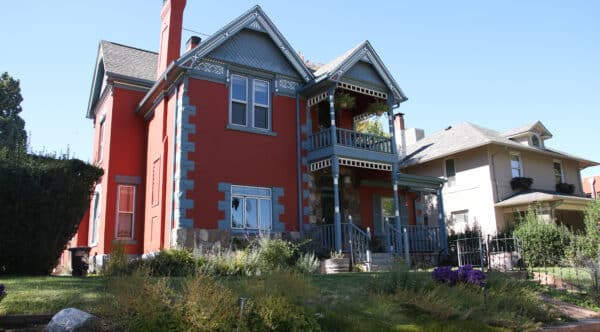
Homes within the Packard’s Hill Historic District in northwest Denver are subject to certain rules when owners try to modify them. Four residents in the district have sued the city twice over the designation. Photos by Eric Heinz.
Four residents have sued the city for a second time in hopes of removing the historic district designation of a portion of the West Highland neighborhood.
The plaintiffs — Carol Purdy, Paul Hudgens, Dee Hayes and Kevin O’Connell — dislike the restrictions the designation places on home alterations, saying they have had difficulty replacing windows and making other minor improvements to their homes because of the rules that govern the historic district.
Purdy said she was not allowed to put up an 8-foot fence to give herself more privacy from a restaurant next door. And when she wanted to replace her windows, she could not afford ones conformed to the district’s guidelines.
“Even the rotted and broken frames were not permitted to be replaced,” Purdy said. “I was not able to go out and purchase double-pane windows that would work for my historic house. The cost to reglaze seven windows was prohibitive, and I ended up using plexiglass inside instead.”
The Denver City Attorney’s Office declined to comment.
The Packard’s Hill Historic District is generally bordered by the alley east of Perry Street and Lowell Boulevard, from 32nd Avenue to 35th Avenue. The residential area has homes that date as far back as the middle to late 1800s, and is notable in part because of “its exceptionally strong association with Denver women’s history,” according to the district’s website.
Homes within historic districts must conform design standards to a particular area, which can be found online at the city’s Landmark Preservation website. The Landmark Preservation Commission approves or denies possible exterior home alterations. Packard’s Hill does not have its own unique design guidelines and follows the general rules.
The most recent lawsuit from the four homeowners, filed at the end of September, challenges a 2019 decision by the Denver City Council to modify the Landmark Ordinance to define historic designations as not part of the city’s zoning process.
That change gave people fewer options to appeal a historic designation, according to the plaintiffs, who are represented by attorney Jordan Porter of J.D. Porter.

Tom Davich, a homeowner within the Packard’s Hill Historic District, says he has received violation notices regarding the changes that were made to his home, which he bought in 2020.
“The two main legal questions are: Is the Landmark Ordinance part of the city’s zoning powers? If yes, then do the effects of the landmark designation fall within the effects of the rights to protest, which are in the Denver charter?” Porter said.
In 2017, shortly after Packard’s Hill Historic District was established, the same plaintiffs sued the city seeking to have its approval overturned because the council did not reach a supermajority when it voted on the issue. The vote on Packard’s Hill was 8-5, and a supermajority requires support by two-thirds of council members.
Supermajorities can be required on certain zoning-related votes when enough nearby residents formally oppose the measure. More than 20 percent of residents in the proposed district opposed the designation in 2017, according to the plaintiffs.
After an appeals court expressed support for the plaintiff’s position in that case, the City Council changed the Landmark Ordinance in September 2019 to say a historic district designation is not an action under the council’s zoning authority.
“City Council’s authority to enact zoning regulations requires that the zoning regulations be uniform for each class or kind of buildings throughout each district … the process for approving historic districts, however, does not include such criteria,” the city said in court documents.
Porter, however, said that historic designation is a change of land use, and owners should be entitled to protest it.
“It looks like Denver is simply too lazy to try to work protest rights into the Landmark Ordinance,” Porter said. “It’s like Denver is trying to subvert these protest rights by doing that cursory amendment.”
The 2017 lawsuit is still ongoing after the appeals court twice remanded it back to the lower district court, said Porter, who previously represented a Thornton woman in her successful fight against a proposed TopGolf location.
The plaintiffs aren’t the only Packard’s Hill residents who oppose the district.
Tom Davich bought his home on 32nd Avenue and Osceola Street in 2020 and said it had been renovated outside the scope of the historic district guidelines. He said he has since received violation notices from the city.
While Davich was made aware of the district before his purchase, he said he didn’t fully understand the impact, and likely wouldn’t have gone through with the buy if he did.
“It’s been really a challenging and really frustrating experience, especially as a first-time homeowner …. I think folks need to be a lot more aware when decisions like (historic districts) come up for a vote because it really does have a lot of impact,” Davich said.

Homes within the Packard’s Hill Historic District in northwest Denver are subject to certain rules when owners try to modify them. Four residents in the district have sued the city twice over the designation. Photos by Eric Heinz.
Four residents have sued the city for a second time in hopes of removing the historic district designation of a portion of the West Highland neighborhood.
The plaintiffs — Carol Purdy, Paul Hudgens, Dee Hayes and Kevin O’Connell — dislike the restrictions the designation places on home alterations, saying they have had difficulty replacing windows and making other minor improvements to their homes because of the rules that govern the historic district.
Purdy said she was not allowed to put up an 8-foot fence to give herself more privacy from a restaurant next door. And when she wanted to replace her windows, she could not afford ones conformed to the district’s guidelines.
“Even the rotted and broken frames were not permitted to be replaced,” Purdy said. “I was not able to go out and purchase double-pane windows that would work for my historic house. The cost to reglaze seven windows was prohibitive, and I ended up using plexiglass inside instead.”
The Denver City Attorney’s Office declined to comment.
The Packard’s Hill Historic District is generally bordered by the alley east of Perry Street and Lowell Boulevard, from 32nd Avenue to 35th Avenue. The residential area has homes that date as far back as the middle to late 1800s, and is notable in part because of “its exceptionally strong association with Denver women’s history,” according to the district’s website.
Homes within historic districts must conform design standards to a particular area, which can be found online at the city’s Landmark Preservation website. The Landmark Preservation Commission approves or denies possible exterior home alterations. Packard’s Hill does not have its own unique design guidelines and follows the general rules.
The most recent lawsuit from the four homeowners, filed at the end of September, challenges a 2019 decision by the Denver City Council to modify the Landmark Ordinance to define historic designations as not part of the city’s zoning process.
That change gave people fewer options to appeal a historic designation, according to the plaintiffs, who are represented by attorney Jordan Porter of J.D. Porter.

Tom Davich, a homeowner within the Packard’s Hill Historic District, says he has received violation notices regarding the changes that were made to his home, which he bought in 2020.
“The two main legal questions are: Is the Landmark Ordinance part of the city’s zoning powers? If yes, then do the effects of the landmark designation fall within the effects of the rights to protest, which are in the Denver charter?” Porter said.
In 2017, shortly after Packard’s Hill Historic District was established, the same plaintiffs sued the city seeking to have its approval overturned because the council did not reach a supermajority when it voted on the issue. The vote on Packard’s Hill was 8-5, and a supermajority requires support by two-thirds of council members.
Supermajorities can be required on certain zoning-related votes when enough nearby residents formally oppose the measure. More than 20 percent of residents in the proposed district opposed the designation in 2017, according to the plaintiffs.
After an appeals court expressed support for the plaintiff’s position in that case, the City Council changed the Landmark Ordinance in September 2019 to say a historic district designation is not an action under the council’s zoning authority.
“City Council’s authority to enact zoning regulations requires that the zoning regulations be uniform for each class or kind of buildings throughout each district … the process for approving historic districts, however, does not include such criteria,” the city said in court documents.
Porter, however, said that historic designation is a change of land use, and owners should be entitled to protest it.
“It looks like Denver is simply too lazy to try to work protest rights into the Landmark Ordinance,” Porter said. “It’s like Denver is trying to subvert these protest rights by doing that cursory amendment.”
The 2017 lawsuit is still ongoing after the appeals court twice remanded it back to the lower district court, said Porter, who previously represented a Thornton woman in her successful fight against a proposed TopGolf location.
The plaintiffs aren’t the only Packard’s Hill residents who oppose the district.
Tom Davich bought his home on 32nd Avenue and Osceola Street in 2020 and said it had been renovated outside the scope of the historic district guidelines. He said he has since received violation notices from the city.
While Davich was made aware of the district before his purchase, he said he didn’t fully understand the impact, and likely wouldn’t have gone through with the buy if he did.
“It’s been really a challenging and really frustrating experience, especially as a first-time homeowner …. I think folks need to be a lot more aware when decisions like (historic districts) come up for a vote because it really does have a lot of impact,” Davich said.
